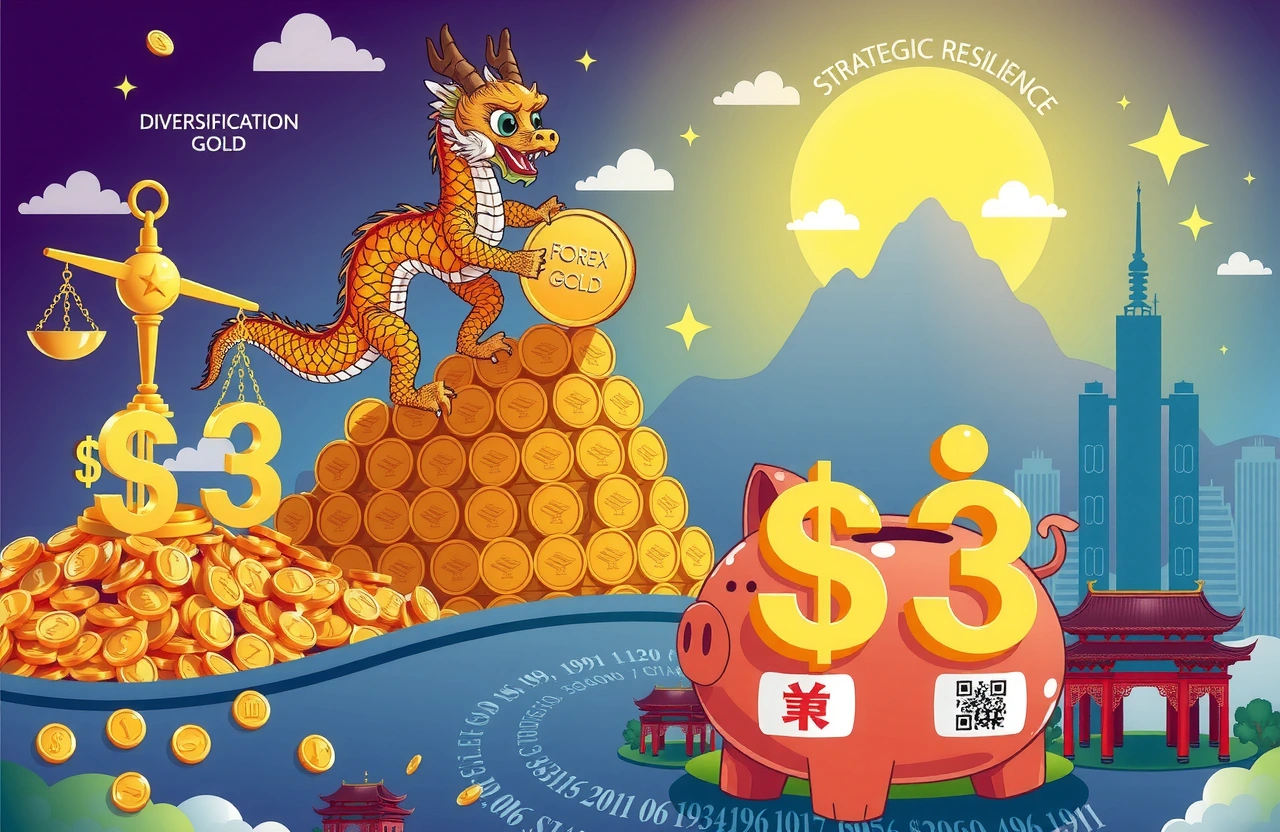China’s Forex Milestone and Gold Strategy
China’s foreign exchange reserves climbed to $3.3174 trillion in June 2025 – the first time exceeding the $3.3 trillion threshold since September 2024. This significant milestone accompanies the People’s Bank of China Governor Pan Gongsheng (潘功胜) adding 70,000 ounces of gold to national reserves, marking the eighth consecutive month of deliberate gold accumulation. These strategic moves unfold against a backdrop of global currency volatility and shifting economic power dynamics.
Article Summary:
- China’s forex reserves grew by $322 million in June 2025, reaching $3.3174 trillion for the first time in nearly a year
- The People’s Bank of China continued its gold acquisition streak for an eighth month
- A falling U.S. dollar and appreciating global assets contributed to reserve growth
- Strategists cite global “de-dollarization” trends as drivers for reserve diversification
- 95% of central banks surveyed plan to increase gold holdings amidst economic uncertainty
Analyzing the Reserve Growth Trajectory
The $322 million monthly increase brings China’s reserves to heights not seen since late 2024. This continuation of a 19-month streak above $3.2 trillion establishes a consistent baseline far exceeding pandemic-era levels. The State Administration of Foreign Exchange (SAFE) specifically cited USD depreciation and global asset appreciation as catalysts – with the U.S. Dollar Index sliding to three-year lows while Euro-denominated assets gained traction.
Currency Valuation Dynamics
June’s 2.5% dollar depreciation mattered significantly since forex reserves value foreign holdings in dollar terms. As non-dollar assets appreciated through currency gains alone:
- Euro positions added approximately 1.8% in dollar-adjusted valuation
- Japanese yen holdings increased 1.2% in dollar terms despite domestic stagnation
- Sterling assets contributed modest gains amid Britain’s recovery efforts
Global Asset Appreciation Effect
Benchmark indexes showed robust June performance:
- Global bond indexes rose approximately 1%
- S&P 500 surged 5% during the period
- Developed market equities collectively gained 3.8%
These broad-based gains enhanced treasury and sovereign wealth fund valuations within China’s reserve portfolio.
Gold Accumulation Strategy
The 70,000-ounce gold addition brings China’s official holdings to 73.9 million ounces – approximately 2,299 metric tons. This consistent accumulation pattern aligns with a global central bank trend documented in the World Gold Council’s 2025 Global Central Bank Reserve Survey showing 95% of surveyed institutions expect continued gold buying. Several strategic drivers underpin this gold strategy:
Reserve Diversification Imperative
Economists confirm diversification motivations remain paramount:
- Gold provides non-correlated stability against currency fluctuations
- Physical bullion avoids counterparty risk inherent in financial instruments
- Historical preservation of wealth during inflationary cycles
As People’s Bank of China Governor Pan Gongsheng explained in a recent policy symposium, “Gold’s unique attributes strengthen reserve resilience during structural market transitions.”
Geopolitical Insurance Policy
The sustained accumulation occurs against escalating global tensions:
- Western financial sanctions against Russia demonstrated asset seizure risks
- U.S. debt ceiling debates raised Treasury reliability questions
- Bilateral trade disputes increasingly involve currency weaponization
Analysts note that sovereign gold holdings provide transaction alternatives should dollar-based systems become politically inaccessible.
The De-Dollarization Context
Q2 2025 witnessed accelerated decline in dollar confidence across emerging markets. The dollar slumped over 10% through early 2025 – its steepest decline since early pandemic fluctuation. This trajectory carried significant implications:
Structural Confidence Concerns
Economist Wen Bin of China Minsheng Bank identified three crucial concerns driving reserve managers away from dollar concentration:
- Erosion of U.S. fiscal discipline amid expanding deficits
- Political influence on Federal Reserve policy compromising neutrality
- Integration of financial infrastructure with foreign policy objectives
These perceptions accelerated bilateral currency agreements bypassing dollar transactions since January 2025.
Global Reserve Portfolio Diversification
Chinese reserve management mirrors broader diversification patterns:
- BRICS nations collectively added 152 tons gold year-to-date
- Southeast Asian central banks expanded gold allocations by average 4.7%
- Sub-Saharan African institutions posted record gold acquisition rates
The IMF’s Currency Composition of Foreign Exchange Reserves data confirms dollar-backed assets now comprise under 60% of allocated reserves – the lowest share since 1995.
Operational Significance of Reserves
Beyond symbolism, China’s reinforced reserves serve critical macroeconomic functions:
Monetary Sovereignty Safeguard
Robust reserves prevent balance of payments crises by ensuring:
- Essential import financing during trade disruptions
- Sovereign debt servicing capacity preservation
- Currency stabilization intervention capability
SAFE officials emphasize reserves’ role as “international payment commitment guarantees.”
Strategic Investment Enabler
Reserve assets facilitate critical infrastructure initiatives:
- Belt and Road participation funding
- Strategic commodity stockpiling during price dips
- Emergency sovereign wealth fund replenishment
Forward-Looking Reserve Strategy
With emerging global economic asymmetries, China’s approach balances preservation and strategic positioning:
Gold’s Continued Role
Li Chao of Zheshang Securities anticipates sustained gold accumulation given:
- Recessionary pressures across major economies
- Persistent inflation concerns despite cooling indicators
- Geopolitical friction across trading corridors
World Gold Council data indicates 43% of central banks intend significant reserve additions within 12 months.
Non-USD Asset Allocation Expansion
Reserve managers appear positioned to increase:
- Euro-denominated debt instruments
- Special Drawing Rights positions
- Bilateral currency swap arrangements
Projections suggest dollar weighting could dip below 55% in China’s portfolio before stabilization.
The dual strategy of reserve augmentation complemented by physical gold accumulation reflects sophisticated geopolitical risk management. For monitoring global reserve trends, analysts should track monthly SAFE disclosures and World Gold Council benchmark studies as these diversification patterns evolve through economic recalibration.



